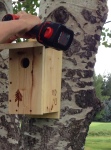‘Tis the time in northern Arizona when many people start asking: “So when are you closing up and heading back to (fill in the blank)?” After all, pine needles are dropping like crazy, occasionally the lovely smell of a wood-burning fireplace permeates the air, fall decorations adorn our doors and tabletops, and we hear about plans for Halloween costumes and parties. It’s that transition time from summer to fall, and the days are usually gorgeous, with the monsoon rains long gone and the spring’s strong and gusty winds hardly thought of anymore.
But where are the Black-Headed Grosbeaks and Anna’s Hummingbirds? They have already headed south to Mexico and South America. The Western Bluebirds, though, are still showing up all over the Pinewood Country Club golf course, pulling out grubs and worms that are just underneath the trail of the electric carts and golfers’ steps. The Yellow-Headed Blackbirds are gone as well, but the Swallows – Barn, Tree, Violet-Green, Rough-Winged – are still around as long as there are plenty of the insects to catch on the fly.
Why do some birds move on and others don’t? Well with people, we’d say “follow the money”, but with birds, it’s all about “follow the food source”. The insects that are sources of food to American Robins, Black-Headed Grosbeaks, Western Bluebirds, and Red-Winged Blackbirds do not exist in our cold northern Arizona winters, so these birds migrate to follow food sources and survive. Other bird species, such as our American Crows, Steller’s Jays, Western Chickadees, and Pygmy and White-Breasted Nuthatches, stay in Munds Park because their food sources extend into the winter.
I recently had a reader approach me and ask if it was normal to see a Steller’s Jay taking peanuts and burying them into the ground. “What was going on, weren’t the birds hungry?” Actually, this is normal behavior for a lot of birds. They were taking the food and caching it for a rainy day, or in bird-speak, for later consumption on a cold and wintry day. Many bird species take nuts and seeds and store them in crevices in trees or in the ground for future use. Acorn Woodpeckers are notorious for this behavior; sometimes there are thousands of acorns in a “grainary” tree, and the woodpeckers even move seeds and nuts from larger holes to smaller holes as the seeds or nuts shrink. It’s all about survival and being prepared for the worst.
The birds that stay year round in Munds Park are the ones that have dependable food sources. Those that migrate need more of an insect diet. Right now is an exciting time for birders in Arizona – everyone is on the watch for the migrants coming through their neighborhoods. For example, the Bird List Serve run by the University of Arizona mentions a migrating Blackpoll Warbler in Chandler, White-Crowned Sparrows showing up, (I always hear them in Scottsdale about the first week of October), and a Blue-Throated Hummingbird in Green Valley.
Probably only one more article to go this season; we are headed to Bryce and Zion Canyons in Utah soon. I haven’t yet researched what special birds we might see on that trip, but I will for sure let you know what I find when I write the last article of 2016. I’m hoping for a Clark’s Nutcracker. In the meantime, please let me know what you see or hear in Munds Park (birds only, please!) while I’m gone!



